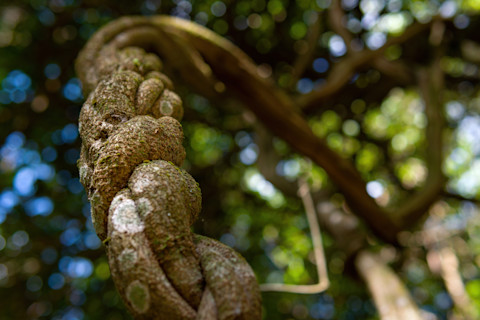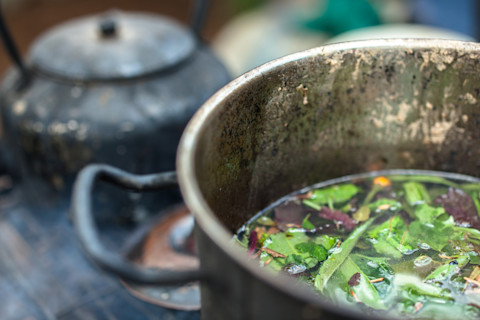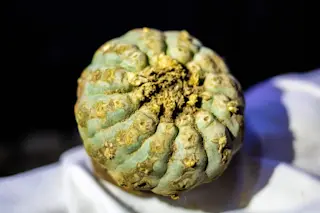At first glance, the peyote and ayahuasca plants may seem similar, but a closer look reveals the intricacies that set them apart. Are they, in fact, the same thing, or do they belong to entirely separate realms?
Learn the unique differences between the side effects and origins of the peyote and ayahuasca plants, two powerful conduits to altered states of consciousness.
What Is Peyote?

Harvested peyote that a person can ingest for psychedelic experiences. (Credit: Photo Spirit/Shutterstock)
Photo Spirit/Shutterstock
Peyote, a thornless cactus, contains the psychoactive compound known as mescaline as its primary hallucinogenic component. Its bitter buttons, which cluster around a central flower, can be eaten raw or dried (crunchy like potato chips) or steeped to make tea.
As a vestige of 1960s drug policy, peyote and mescaline remain Schedule I controlled substances, like heroin and LSD.
Aldous Huxley and Peyote
Huxley’s account of his experience, 1954’s The Doors of Perception, popularized psychedelic experimentation in general and the peyote cactus in particular.
On an afternoon in May, 1953, author Aldous Huxley drank a glass of dissolved mescaline, the main psychoactive ingredient in the peyote cactus, and found his home rather transformed. At one point, he looked at a flower arrangement he had appreciated that morning in a clear-headed state for its colors.
“But that was no longer the point,” Huxley writes. “I was not looking now at an unusual flower arrangement. I was seeing what Adam had seen on the morning of his creation – the miracle, moment by moment, of naked existence.”
What Does Peyote Do?
Mescaline, the primary ingredient in peyote, is known for its slow come-on and LSD-like effects, which can include visual, auditory and tactile hallucinations, loss of personal identity, distorted perception of time, and novelty enhancement. This is probably why Huxley so dramatically reconsidered his flower arrangement.
There are more onerous side effects of peyote thanks to its chemical structure, including nausea, vomiting, abdominal pain, sweating, and increased heart rate. As such, its use has fallen so low that it accounted for just 116 out of 2.8 million cases reported to poison control in 2007.
Where Does Peyote Grow?

Cactuses and peyotes in Arizona’s Tonto National Forest, Arizona desert, USA (Credit: Arbuzov Sergei/Shutterstock)
Arbuzov Sergei/Shutterstock
Peyote grows in the American southwest and Mexico, and early Americans started taking it as early as 3,780 B.C., according to one study.
Their successors, members of the present-day Native American Church, still consume it today under a special exception for ceremonial use.
Tough to gather and cumbersome to traffic, peyote buttons fell out of favor as alternatives such as psilocybin mushrooms and LSD can be grown in home basements or synthesized in small labs, respectively.
Read More: Our Ancestors Got High, Too
What Is Ayahuasca?

Jagube vine, plant used to make ayahuasca (Credit: Matheus Pedalino/Shutterstock)
Matheus Pedalino/Shutterstock
Another traditional psychedelic, ayahuasca, has skyrocketed to prominence in recent years, thanks in part to the popularity of ayahuasca ceremonies modeled after traditional Amazonian ones.
It contains Dimethyltryptamine (DMT), a chemical that, like mescaline, activates a certain group of serotonin receptors, which may enhance cognition at lower doses (see: microdosing).
What Does Ayahuasca Do?
At high doses, dimethyltryptamine in Ayahuasca induces the profound hallucinogenic effects common to serotonergic psychedelics. Like other psychedelics, ayahuasca has emerged as a potential treatment for mental illness.
A 2022 study followed 40 subjects who consumed the “medicine” and observed a sharp reduction in mental illness: While some 45 percent of the initial sample met the criteria for a mental disorder, ayahuasca seemed to have cut that group in half by the one month check-in.
How Is the Ayahuasca Plant Made Into Tea?

Ayahuasca brew (Credit: Dana Toerien/Shutterstock)
Dana Toerien/Shutterstock
Ayahuasca brew is made from boiling the vines of the Ayahuasca plant with the leaves of the chacruna plant.
It can be brewed in anything from a cauldron to a slow cooker, although the ingredients containing Dimethyltryptamine can be hard to come by as the substance, like mescaline, is still on Schedule 1.
Where Did the Ayahuasca Ceremony Originate?
The Ayahuasca ceremony dates back to at least 900 B.C. in Peru. Now seekers have turned to retreats in South America, or to new churches in the U.S. that use the brew as a sacrament and claim legal protection under a 2006 Supreme Court ruling.
Read More: Do Psychedelic Drug Therapies Actually Require Getting High?
Peyote vs. Ayahuasca
So, what is the difference between peyote and ayahuasca? Thanks to the dimethyltryptamine it contains, ayahuasca is a more powerful hallucinogenic than peyote or LSD.
It is capable of producing visionary experiences in which users “break through” into other planes of existence or communicate with beings such as elves or plant creatures that may carry spiritual significance for the user.
Like peyote, ayahuasca causes gastrointestinal irritation and vomiting, but the latter’s ability to then “make it worth it” has led to its popularity, and many drinkers believe the vomiting or diarrhea intensifies the experience to come.
What Are the Origins of Ayahuasca?
Ayahuasca has its origins in Amazonian indigenous cultures, particularly among the indigenous peoples of Peru, Ecuador, and Brazil. It is deeply rooted in their shamanic and healing traditions.
What Are the Origins of Peyote?
Peyote is closely associated with indigenous tribes in North America, such as the Huichol and Native American Church. It has a long history in these cultures and is often used in spiritual and healing rituals.
What Are Ayahuasca Ceremonies?
Ayahuasca ceremonies are typically highly structured and guided by experienced shamans or facilitators. These ceremonies often take place in designated ceremonial spaces, involve chanting, singing, and specific rituals, and the shaman plays a central role in guiding participants.
What Are Peyote Ceremonies?
Peyote ceremonies are generally less formal and structured. They are often held in natural settings, such as desert environments. While they can be guided by a ceremonial leader, they are typically more informal, with a focus on individual experiences and introspection.
What Are the Side Effects of Ayahuasca?
Ayahuasca can induce intense and sometimes purgative effects, including vomiting and diarrhea. It is known for producing powerful visionary experiences, which can be psychologically challenging. Some users may also experience emotional turmoil during the journey.
What Are the Side Effects of Peyote?
The side effects of peyote are generally milder. They can include nausea and occasional vomiting, but these effects are not as pronounced as in ayahuasca. The visual and sensory effects of peyote are often described as more gentle and introspective.
What Are the Primary Ingredients of Ayahuasca?
The primary ingredients in ayahuasca are the ayahuasca vine (Banisteriopsis caapi) and the leaves of the chacruna shrub. The combination of these plants creates a brew that contains dimethyltryptamine (DMT).
What Are the Primary Ingredients of Peyote?
The primary ingredient in peyote is the peyote cactus (Lophophora williamsii). The active compound in peyote is mescaline, which is known for inducing altered states of consciousness.
Read More: Psychedelics Could Be the Future of Psychotherapy
This article was originally published on March 23, 2023 and has since been updated by the Discover staff with new information.














